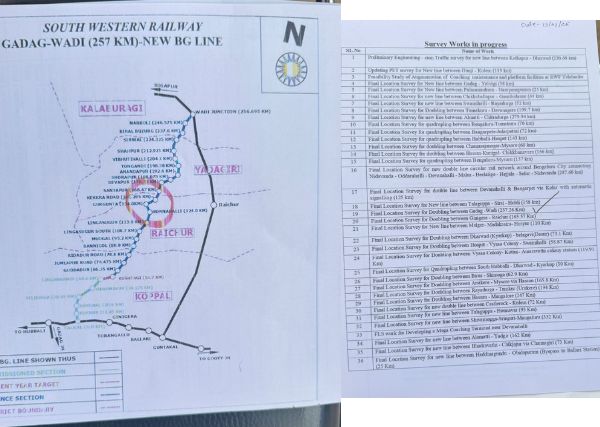Century-Old Railway Dream Gains Momentum: Hutti Gold Town's Rail Link Gains State and Central Attention
In a remarkable revival of a transportation plan dating back to 1913, the demand for a dedicated railway line connecting Raichur–Lingasugur–Hutti Gold Mines has regained national attention.
Once outlined in the historic Railway Age Gazette, the proposed rail route is now being actively pursued by local civil society, Karnataka legislators, and central ministries, rekindling hopes of long-overdue connectivity for the gold-rich region of Hutti.
Residents of Hutti, home to one of India’s oldest and only operational gold mines, recently met with Raichur MP G. Kumar Naik to demand parliamentary intervention.
With support from community leaders, state lawmakers, and now central ministries, momentum is building toward realizing a vision first documented over 112 years ago.
The delegation—led by Hatti Pattana Naagarika Samiti, Manava Bandhutva Vedike, and Nava Bharatha Hindu Dalita Sangha—submitted a formal memorandum urging immediate action.
Community leaders including Lal Peer and Suresh Gowda Guruker highlighted the economic significance of the mines and the adverse impact of inadequate rail logistics on growth, employment, and mobility in the region.
During a historic session of the Karnataka Legislative Assembly on 13 July 2025, multiple MLAs raised the issue of Hutti’s lack of rail connectivity.
The House officially recognized Hutti's inclusion in the government railway line gazette, marking a legislative first for the region.
Legislators also invoked the legacy of Basvaraj Rajarajeshwari of Gajjalgatta, proposing that future infrastructure be named in her honor as a tribute to the region’s cultural roots.
The session included references to the Nizam-era neglect of Hutti, when the area was left disconnected despite its economic importance.
The campaign reached Delhi when the Ministry of Mines acknowledged a public grievance filed by Shri Srinivasalu R of Karnataka (Grievance No. PMOPG/E/2025/0059775), requesting a new railway alignment via Hutti Gold Mines as part of the Gadag–Wadi line.
In a memorandum issued on 6 May 2025, Deputy Secretary Maneesh Kumar confirmed that the matter had been forwarded to the Ministry of Railways and Ministry of Road Transport & Highways for further action, marking a formal escalation of the issue to national policy-makers.
This push comes as Indian Railways conducts 36 active survey projects across Karnataka and nearby states. Among them, the Gadag–Wadi Broad Gauge (BG) line, covering 257 km, is making steady progress.
Key stations in the proposed alignment include Ginigera, Kushtagi, Mudgal, Lingasugur, Shahpur, and Wadi—with Hutti likely to be integrated into the network. The project is expected to decongest freight corridors, enhance mining transport, and link North Karnataka districts such as Raichur, Yadgir, Kalaburagi, Koppal, and Gadag.
Historically, the Nizam’s Guaranteed State Railways had proposed connecting Secunderabad to Raichur and Gadag in the early 1900s—showcasing how Hutti has long been strategically relevant, yet repeatedly overlooked in infrastructure planning.
For the people of Hutti, this is more than a rail link—it’s a symbol of economic opportunity, regional equity, and historical justice. Citizens believe that this long-awaited infrastructure could unlock local industries, improve mobility for workers, and integrate Hutti into the national economy.
With support from community leaders, state lawmakers, and now central ministries, momentum is building toward realizing a vision first documented over 112 years ago.
“This isn’t just about tracks and trains,” said one activist. “It’s about finally putting Hutti on the map where it has always belonged—connected, recognized, and ready to grow.”
Over a century after it was first proposed in a 1913 edition of the Railway Age Gazette, the call for a railway line connecting Raichur–Lingasugur–Hutti Gold Mines is once again gaining strong traction—this time with unified backing from local citizens, Karnataka Assembly members, and the Government of India.
Author: Mohammed Hussain
Hutti Gold Mines

.jpg)






Comments
Post a Comment